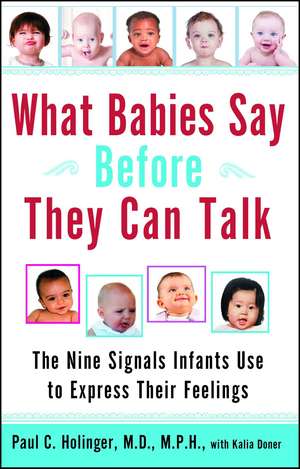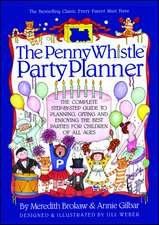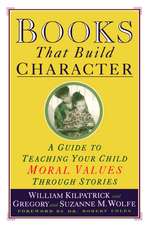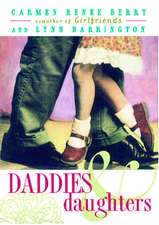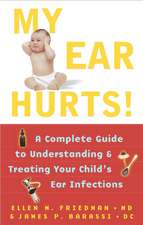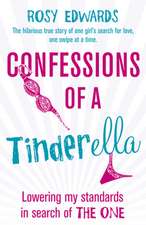What Babies Say Before They Can Talk: The Nine Signals Infants Use to Express Their Feelings
Autor Dr. Paul Holinger Cu Kalia Doneren Limba Engleză Paperback – 4 aug 2003
Dr. Holinger decodes the nine easily identifiable signals—interest, enjoyment, surprise, distress, anger, fear, shame, disgust (a reaction to bad tastes), and dissmell (a reaction to bad smells)—that all babies use to express their needs and wants. These insights will aid parents in discerning what their baby is feeling. This book can help all parents become more confident and self-aware in their interactions with their children, create positive communication, and put the joy back into parenting.
This is a unique work. It provides a foundation for understanding feelings and behavior. Based on emerging research, What Babies Say Before They Can Talk offers parents a new perspective on their babies' sense of the world and the people around them. The goal of this book is to help parents enhance their infants' potential, prevent problems, and raise happy, healthy, responsible children.
Preț: 114.80 lei
Nou
Puncte Express: 172
Preț estimativ în valută:
21.97€ • 22.85$ • 18.14£
21.97€ • 22.85$ • 18.14£
Carte disponibilă
Livrare economică 24 martie-07 aprilie
Preluare comenzi: 021 569.72.76
Specificații
ISBN-13: 9780743406673
ISBN-10: 0743406672
Pagini: 288
Ilustrații: 35 b-w photos, 4 b-w line gaphs
Dimensiuni: 140 x 216 x 18 mm
Greutate: 0.31 kg
Ediția:Original
Editura: Touchstone Publishing
Colecția Touchstone
ISBN-10: 0743406672
Pagini: 288
Ilustrații: 35 b-w photos, 4 b-w line gaphs
Dimensiuni: 140 x 216 x 18 mm
Greutate: 0.31 kg
Ediția:Original
Editura: Touchstone Publishing
Colecția Touchstone
Notă biografică
Paul C. Holinger, MD, MPH, is a psychiatrist and child/adult psychoanalyst. He is Professor of Psychiatry at Rush-Presbyterian-St. Luke's Medical Center, Chicago. He is also Faculty, Training/Supervising Analyst at the Chicago Institute for Psychoanalysis.
Extras
Introduction
My Journey: On the Road to Raising Happy, Capable, Responsible Children
Human beings are born with a set of signals. Current research suggests there are nine inborn signals: interest, enjoyment, surprise, distress, anger, fear, shame, disgust (a reaction to bad tastes), and dissmell (a reaction to bad odors). These are our earliest feelings. In time, these signals combine with each other and link up with experience to form our complex emotional life. Understanding these signals and how they work can make a world of difference for you and your baby. That is what this book is all about.
I'd like to introduce myself and describe how I came to be involved in the field of child development. I am a medical doctor, specializing in psychiatry and psychoanalysis. I enjoy sports, I love learning and, most important, I am the father of a ten-year-old boy. I think it is very important to help parents understand their children, so that these children might reach their full potential as happy, capable, responsible human beings.
From an early age, I've been interested in psychology -- in part because as a child I had the sense that my well-meaning parents didn't understand what I was feeling. When I headed off to college I knew that I wanted to major in psychology and then go on to medical school and become a psychiatrist. I received my psychiatric training in Chicago, and then went to Harvard University School of Public Health in Boston to study psychiatric epidemiology -- the study of the frequency and distribution of mental disorders. While in Boston, I became fascinated with the idea of prevention -- rather than just treatment -- of emotional problems. The theme of preventing emotional turmoil grew even stronger when I began treating adolescents and doing research on teenage violence and suicide. However, there was another piece to the puzzle. I returned to Chicago to set up practice and train in child and adult psychoanalysis. I wanted to understand the emotional life of children and adults in real depth and use that understanding to help my patients.
Since then I have worked with children as well as adult patients. Some patients require as many as five sessions a week. I have found that this kind of intense work allows patients to understand themselves and make progress in ways that no other kind of treatment provides. Yet, I have remained focused on preventing emotional suffering. I wondered: "What if I had been able to see Erik [a twenty-five-year-old patient], when he was five, and had worked with him and his parents then?" "What if I could have seen Margie's parents [a thirty-five-year-old woman with whom I worked four times per week for seven years with a very successful outcome] when she was an infant?" Could Erik and Margie have been spared the pain they struggled with as teenagers and adults?
I wondered how personalities were formed. I questioned how an individual's inborn attributes contribute to his or her emotional development and what role the environment -- parents, caretakers, and social context -- plays in the emergence of emotional problems later in life. I thought it was not enough to help troubled families and children, not because they can't be helped -- they can make enormous progress in the quality of their lives -- but because I felt compelled to find ways to prevent the problems from starting in the first place. I often recalled the words of Helen C. Boyden, a wonderful, wise woman who was my high school chemistry teacher: "The trouble you don't get into, you don't have to get out of!"
Remarkable successes have been achieved in the fields of psychiatry and psychoanalysis. However, in my opinion, we have come up short in two areas. First, we have not focused enough on prevention, and second, we have not done a good job of conveying to the public much of what is known in the area of child development. When talking about prevention of emotional problems, I am referring to the conflict, depression, and anxiety that can result from the misunderstanding and poor regulation of feelings; I am not referring to the major psychotic illnesses with biological components such as schizophrenia or bipolar disorder, although understanding these earliest feelings can help in those conditions as well. I hope my professional colleagues will appreciate that I am trying to convey in readable fashion various features of the preverbal affective world of the infant and caregiver and the tension-regulation issues involved.
During the twentieth century, research and clinical advances provided hope that prevention, not just treatment, of some aspects of emotional problems was possible. I immersed myself in data and theories about the way children's emotions develop and how they communicate their earliest feelings. A number of researchers such as Ainsworth, Bowlby, Demos, Emde, Greenspan, Lichtenberg, Main, Panksepp, Plutchik, Schore, Spitz, and Stern have made significant breakthroughs in understanding the development and neurobiology of human emotions, and clinicians such as Basch, Freud, Gedo, Goldberg, Kernberg, Kohut, Modell and Winnicott have made significant advances in treatment of emotional problems in children and adults. Ultimately, the conclusions in this book are based on five sources of data: clinical work with adult and children; studies of infants; research on evolution; brain investigations; and the findings of early intervention and prevention programs.
The study of human emotions is extremely complex, and many perspectives, theories, and data exist (for example, see Plutchik's The Psychology and Biology of Emotion and Panksepp's Affective Neuroscience, listed in the Resources section). However, throughout this book I will focus on three scientists and their work. These three have been particularly influential in my efforts to help parents raise happy, capable, responsible children.
The first scientist is Silvan Tomkins. Tomkins produced a four-volume work titled Affect Imagery Consciousness, which is an extensive exploration of emotional life. Tomkins and his colleagues Demos, Ekman, Izard, and Nathanson built on Darwin's work (e.g., The Origin of Species; The Expression of the Emotions in Man and Animals) and researched the inherited nature and development of human emotions. They concluded that all humans are born with biological responses to stimulation (affects, or signals), which provide for both communication and motivation, interact with each other, combine with experience, and determine how we act.
Daniel Stern, an infant researcher, is another major influence. His 1985 book The Interpersonal World of the Infant is a classic that changed how infancy is viewed. Stern emphasized that infants have significant social interactions from their earliest moments, and he demonstrated how parents' early validation of -- and responses and attunement to -- their children has a profound influence on the positive development of emotional life.
Lastly, Alexander Meltzoff's work has been a major influence on my thinking. Building on the earlier works of Darwin and Freud, Meltzoff and others have studied the tendencies of infants to identify with and imitate the important people in their lives. These complex research studies help us to understand the conscious and unconscious ways in which children become similar to and different from their parents.
During the time I was exploring emotions in infants and children, my wife and I had a son. As I spent time with other parents and their children, I found that the ideas of these researchers and clinicians made practical sense. All this information seemed to confirm that a child's emotional character -- whether confident, inquisitive, optimistic, loving, and self-confident, or suspicious, pessimistic, and defensive -- is formed by a complex web of influences made up of a child's genetic endowment, his earliest encounters with parents and the outside environment, and, later on, other experiences and developmental processes. But, most striking was my own realization that an understanding of the nine signals could make a positive difference in the development of the child's emotional life.
In my work, I saw that focusing on the child's signals could produce quite remarkable results. I remember a couple who stifled their five-year-old daughter's expressions of distress and anger. They shamed her into bottling them up, making her feel that she was a terrible child for feeling anger at all. As a result, their little daughter became quite obsessive and inhibited. I could have prescribed medication, but I thought that talking with her and her parents and trying to understand her thoughts and feelings would ultimately be of most help. So, I worked to help the parents appreciate that their child's signals for distress and anger were natural inborn responses hardwired in the brain and that these signals were necessary to convey certain information. Over time, the parents were better able to allow and encourage their daughter's expression of these signals. Validating the child's signals and learning how to respond to them appropriately eased the child's -- and the parents' -- distress. This little girl responded quite positively to treatment.
These ideas about signals and feelings also seem to work with so-called high-risk families, that is, families whose children are at significant risk of developing emotional disorders due to poverty, poor education, and lack of parental understanding of how to raise children. David Olds and his colleagues in Colorado have developed brilliant, successful early intervention and prevention strategies with a focus on understanding and regulating feelings. Similarly, Deborah Gross and her colleagues in Chicago studied young children who were at risk of developing conduct disorders and antisocial problems. They concluded that helping parents understand child development and feelings significantly decreased the number of children developing these problems when compared with families without such help.
Over time, then, I've seen the ideas about the signals and feelings work not just with patients and children at risk, but with children and parents in everyday real life. If you maximize your child's positive feelings -- such as the signals for interest and enjoyment -- and allow the child to express the signals for distress, anger, fear, and shame, and then you attend to the causes of those negative feelings, you'll have a happier, healthier child and parent.
The first part of this book looks at how children are born with the innate capacity to express their feelings using a preverbal communication system of nine signals. It also explores how the environment influences a child's feelings and expressions of those signals. Then the book asks you, as parent or other caregiver, to take time to examine yourself. You will have the chance to reflect on who you are emotionally and intellectually and to understand how you may influence the way your child develops.
The second part of the book explains each of the nine signals in detail and discusses ways in which parents and caregivers can respond wisely and appropriately to these signals.
It is my sense that all of us, all parents and caregivers -- those who are at ease and those who are slightly bewildered, those who have already had three kids to learn from and those who are greeting their first child -- can benefit from understanding the nine affects. And so do the children. The first twenty-four months of your child's life is a time when your baby's knowledge base is increasing by leaps and bounds, and it's a time when yours is too.
However, this book is about more than infancy. It focuses on the nine inborn signals, the embryology of emotional life, and the interaction with the environment during the preverbal years. Yet the nine affects and patterns explored here have relevance for you and your child far beyond your child's preverbal years -- into toddlerhood, later childhood, adolescence, and adulthood. You may even find yourself understanding more about your own inner life and psychological dynamics. Parenthood is also a developmental stage in human life. You learn as you do, and the doing changes you and your child forever.
Copyright © 2003 by Paul C. Holinger, M.D., and Kalia Doner
Cuprins
Contents
INTRODUCTION: My Journey: On the Road to Raising Happy, Capable, Responsible Children
PART ONE: Understanding Your Infant...and Yourself
ONE: Welcome to Baby's World
TWO: The Foundation of Feelings: The Nine Basic Signals
THREE: Responding to Your Infant's Signals: The Five Keys
FOUR: Responding to Signals As Your Child Grows: Watching the Vocabulary Become
More Complex
FIVE: Cultivating Compatibility: How Understanding the Signals Helps You and Your Child Get Along
SIX: Encouraging Playfulness
SEVEN: "I Want to Be Like You, Mom and Dad!": How and Why Children Identify with Their Parents
EIGHT: Building Your Child's Self-Esteem
NINE: Turning Off Your Parenting Autopilot...: Identifying and Dealing with Your Assumptions About Being a Mom or a Dad
TEN: ...And Becoming a Clued-In Parent: Getting to Know Your Child
PART TWO: The Signals
Signals of Fun:
ELEVEN: Interest
TWELVE: Enjoyment
THIRTEEN: Surprise Signals for Help:
FOURTEEN: Distress
FIFTEEN: Anger
SIXTEEN: Fear
SEVENTEEN: Shame
EIGHTEEN: Disgust and Dissmell
NINETEEN: Beyond Signals: When Language Emerges and the Signals Transform into Words
TWENTY: Reflections on Discipline and Limits
EPILOGUE: As Your Child Gets Older...
APPENDICES:
A Guide to Further Insights
Charts
Resources
INDEX
INTRODUCTION: My Journey: On the Road to Raising Happy, Capable, Responsible Children
PART ONE: Understanding Your Infant...and Yourself
ONE: Welcome to Baby's World
TWO: The Foundation of Feelings: The Nine Basic Signals
THREE: Responding to Your Infant's Signals: The Five Keys
FOUR: Responding to Signals As Your Child Grows: Watching the Vocabulary Become
More Complex
FIVE: Cultivating Compatibility: How Understanding the Signals Helps You and Your Child Get Along
SIX: Encouraging Playfulness
SEVEN: "I Want to Be Like You, Mom and Dad!": How and Why Children Identify with Their Parents
EIGHT: Building Your Child's Self-Esteem
NINE: Turning Off Your Parenting Autopilot...: Identifying and Dealing with Your Assumptions About Being a Mom or a Dad
TEN: ...And Becoming a Clued-In Parent: Getting to Know Your Child
PART TWO: The Signals
Signals of Fun:
ELEVEN: Interest
TWELVE: Enjoyment
THIRTEEN: Surprise Signals for Help:
FOURTEEN: Distress
FIFTEEN: Anger
SIXTEEN: Fear
SEVENTEEN: Shame
EIGHTEEN: Disgust and Dissmell
NINETEEN: Beyond Signals: When Language Emerges and the Signals Transform into Words
TWENTY: Reflections on Discipline and Limits
EPILOGUE: As Your Child Gets Older...
APPENDICES:
A Guide to Further Insights
Charts
Resources
INDEX
Recenzii
Pamela C. Cantor, Ph.D. Harvard Medical School author of Understanding Children and Youth If I could own only one book on parenting and children, What Babies Say Before They Can Talk would be it!
